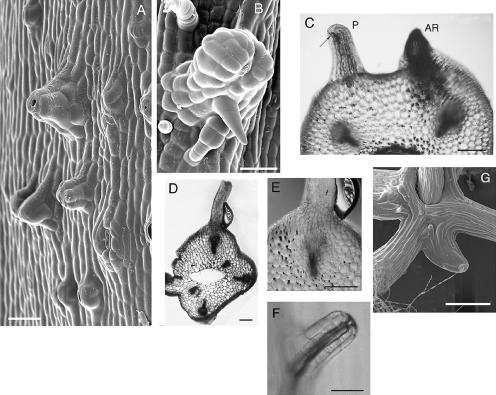Figure 2.
A–F, Protuberances generated in the apical zone of cucumber hypocotyls after transient exposure to ethylene. Protuberances shown in A–C and F were formed in response to a 2-d exposure to 10 μL L−1 ethylene at day 3, followed by 2 (A and F) or 4 (B and C) d in normal air. Protuberance shown in D and E was produced after one week exposure to ethylene produced by including a ripe apple in the container from time of planting, followed by 5 d incubation in normal air. A and B, Scanning electron micrographs of protuberances. A, Early stage protuberances from the apical zone 2 d after ethylene removal. Terminal stomata are evident. B, Mature protuberance with trichomes 4 d after ethylene removal. Bars = 50 μm in A and B. C, A transverse hand section from a seedling 4 d after ethylene removal includes both a protuberance (P), which terminates with a stoma (arrow), and an adventitious root (AR). Bar = 200 μm. D, A hand section cut longitudinally through a protuberance formed after 7 d coculture with an apple, followed by 5 d in normal air. Note vascular tissue subjacent to the protuberance and the central air-filled cavity. Bar = 300 μm. E, Higher magnification image of D shows continuity of the protuberance with the surrounding epidermis and vascular tissue. Bar = 300 μm. F, An early stage protuberance (2 d after ethylene removal) has a snorkel-like appearance with an air-filled chamber (dark region) beneath the terminal stoma. Bar = 50 μm. G, Protuberance formation in the upper hypocotyl of a 2-week-old Arabidopsis seedling that had been exposed to 10 μL L−1 ethylene during its first week of growth. Bar = 500 μm.

